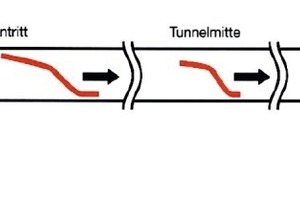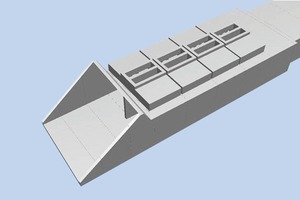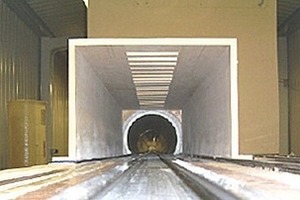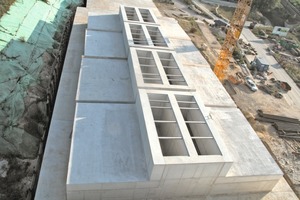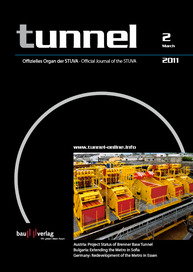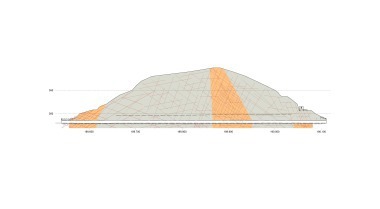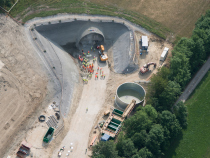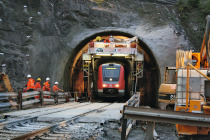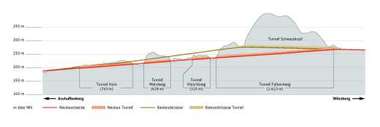Katzenberg Tunnel: special Portals prevent Noise
Compared to 2-track tunnels, single-track long tunnels with a slab track, which can also be used by emergency vehicles, fulfil the highest demands for a safety and rescue concept. As result since 1998 when building long tunnels, single-track bores are recommended in the interests of safety. Given fast train services, however, they possess the constructional disadvantage that loud noises can occur resulting from micro pressure waves (MPW) on account of the substantially smaller cross-section when trains are entering or leaving the tunnel. For trains create a pressure wave with the speed of sound in front of them, which is enhanced in long tunnels because of the suddenly decreased cross-sectional size: the pressure at the rear of the wave is then higher than in front; this is accompanied by a slightly higher temperature and a somewhat higher speed of sound at the rear of the wave. Consequently the rear section of the wave moves faster than the front one and the pressure gradient becomes ever greater – or rather steeper. At the end of the tunnel the pressure wave suddenly emits noise providing the gradient is steep enough (Fig. 1).
Such sound emissions in association with a bang represent a nuisance for the immediate neighbourhood. Furthermore the sudden change of pressure can hurt passengers` ears. Pressure waves of this kind do not form in twin-track tunnels with ballast track beds.
The probability of such a tunnel bang known as a sonic boom by experts occurring is increased
- bytrains travelling at high speed (250 to 300 km/h),
- unfavourable train design,
- small tunnel cross-section (given an area of 60 m²),
- tunnel lining with a low area of friction (inner shell) and
- tunnel lining with slab track instead of ballast.
In order to avoid the bang in the tunnel or considerably lessen its effects various countermeasures of a structural and operational nature were developed in accordance with national and international investigations:
- openings in the tunnel ceiling at the tunnel portal to balance the pressure (Fig. 2),
- enclosures at the tunnel portal (dome structures) (Fig. 3),
- enlarged cross-section at the tunnel exit,
- increasing the tunnel’s capacity to absorb sound by means of structured surfaces (special inner lining), sound absorbers in the track zone of the slab track etc.),
- deployment of trains with aerodynamic nose design,
- reducing the entry speed and
- no ventilation and exhaust shafts in the tunnel.
Structures prevent Tunnel Boom
During the building of the almost 10 km long Katzenberg Tunnel (box) for a travelling speed of 250 km/h a means of construction was applied for the first time in Europe, which resulted in the pressure of the MPWs being decreased by introducing wide ventilation slots in the portal areas, namely at:
- the north portal with a portal dome featuring wide ventilation slots (Fig. 4) thanks to which the pressure is reduced during entry, and
- at the south portal on account of local conditions, slots at the side between both tunnel bores, thanks to which the pressure wave of the incoming train can spread; a dome with window openings prevents the creation of a tunnel boom in the opposite exit portal.
In the tunnel sections produced by cut-and-cover at the 2 portals, the 2 dome structures, each 50 m long, were incorporated in economic terms. Consequently the optimised portal form protects the local residents in Efringen-Kirchen and Bad Bellingen at the north and south portals and passengers in the trains at the same time. The findings obtained here are to be included in codes of practice for future tunnels. G.B.

